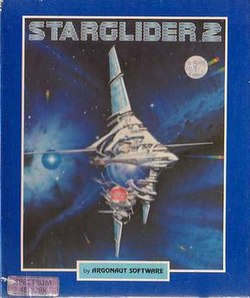Starglider 2
| Starglider | |
|---|---|

Cover art of Starglider 2
|
|
| Developer(s) | Argonaut Games |
| Designer(s) | Jez San, Richard Clucas |
| Platform(s) | Amiga, Atari ST, DOS, Macintosh, ZX Spectrum |
| Release date(s) | 1988 |
| Genre(s) | Space flight simulator game |
| Mode(s) | Single player |
Starglider 2 is a 3D space simulator/flight simulator video game released in 1988 by Argonaut Games and was the sequel to Starglider. It was released for the Amiga, Atari ST, MS-DOS, Apple Macintosh and ZX Spectrum.
The game uses solid shaded 3D polygonal graphics (only on 16 bit versions), and features open, continuous gameplay without levels or loading screens after the game had started, despite taking place across an entire planetary system. The player can fly through space, enter a planet's atmosphere, explore the surface, and penetrate subterranean tunnels in one seamless movement.
The goal of Starglider 2 is to destroy an enemy space station with a neutron bomb, and the majority of the gameplay consists of collecting parts for the bomb, or fulfilling other prerequisites (e.g. finding the nuclear professor capable of constructing the bomb, or trade goods for the bombs necessary to destroy the shield generators protecting the space station), while fighting off enemy spacecraft, and delivering collected items to depots inside planetary tunnel systems. The various objects needed to complete the game are distributed across the many planets of the solar system, as well as in the intervening space (e.g. asteroids and space pirates), or even in the atmosphere of the gas giant planet.
The flight model is arcade-style as opposed to realistic, as the game features no inertia; the spacecraft banks like an aircraft to turn, in air, outer space, and underground; and it is possible to hover. In addition, the game features many graphic display options, including the ability to eliminate roll, or view the game from outside the cockpit from a non-chase-camera, making it difficult to fly but allowing the player to view the polygonal model of the spacecraft.
...
Wikipedia
